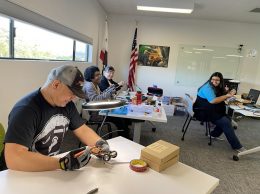Mega merger puts Rosetta and SLO in spotlight
IN THIS ARTICLE
- Central Coast Topic
- Henry Dubroff Author
By Henry Dubroff Friday, August 9th, 2013
It’s a very long way from the canyons of Madison Avenue or the boulevards of Paris to Rosetta’s sleek new building near the airport in San Luis Obispo.
But the successful creation of the world’s biggest advertising agency will depend in part on what happens within the walls of Rosetta, and other niche agencies, that comprise the digital marketing crown jewels for Publicis Groupe, one of a handful of global companies based in France.
Publicis and rival Omnicom, based in New York, stunned the advertising world on July 31 when they announced plans to merge, potentially creating a behemoth with combined market capitalization of $25 billion. Publicis counts Saatchi & Saatchi and Leo Burnett among its biggest brands while Omnicom is the parent of legendary advertising agencies including names such as BBDO and DDB and a vast network of U.S. based corporate clients.
In their official press announcements, Publicis and Omnicom were quick to point out that some $500 million in costs savings through consolidation and better purchasing power will help make the merger profitable for shareholders.
But in a post-merger phone conversation with analysts, Omnicom CEO John Wren and Maurice Levy, head of Publicis made it clear that building a combined agency with a bigger digital footprint was also a key goal.
“Our customers are demanding a much broader portfolio of assets,” Levy said, adding that the combined agency will be capable of “addressing the issues of connecting with the consumer through channels which are much more complex than in the past.”
Wren said the goal of the merger was to deploy talent to generate “synergy and innovation for stakeholders.”
Which is where Rosetta and its complementary agencies come in.
Rosetta, whose west coast headquarters and technology center is lodged in San Luis Obispo, is an expert at helping corporate clients understand how to use large digital platforms in combination with traditional media to develop unique customer relationships.
So successful has the team led by top executive Tom Adamski been in developing its approach to customer engagement that he was named CEO of all Rosetta operations in January, just a few months before the agency moved into its new 48,000-square-foot, green-certified headquarters. The work force at the new facility, currently about 150, is slated to double to 300 over the next few years.
In a note to clients, Rosetta, based in Princeton, N.J. said it welcomed the merger, which still must go before regulators for approval. As a stand-alone brand within Publicis, Rosetta said the merger “creates an enormous opportunity to drive innovation at scale.”
The size of that scale is just becoming apparent to an industry that, as chronicled in the TV series “Mad Men,” has been built on designing creative campaigns that traditionally connect large car makers, distillers or consumer products companies to customers through brainy television or print advertising.
But digital channels now constitute nearly 20 percent of all ad spending at around $88 billion a year, with search as a key component. By 2016, digital will draw close to 25 percent of ad spending, or roughly $140 billion, according to research cited in The Economist.
Because of the role of “big data” number crunching, analytics and scale in the brave new world of advertising, the magazine dubbed the next generation of ad agency gurus the “Math Men.”
The digital edge
There’s little doubt among advertising agency insiders and other experts that the edge in understanding digital media to belongs to Publicis, in part because of agencies like Rosetta — which acquired Adamski in its purchase of SLO-based Level Studios — and sister agency Razorfish. That’s largely because these agencies were built in response to the digital revolution. What Omnicom provides is a bigger traditional agency platform and client list to exploit opportunities in digital media and in emerging markets.
Although there are inherent risks in any mega-merger, Jordan Levine, who watches regional trends at Los Angeles-based research firm Beacon Economics, said the rationale for the Publicis-Omnicom merger fits into a narrative that is shaping the post-recession economy across the state.
“This is one of the areas where California has done particularly well,” he said adding that “in the more tech-heavy areas one of our strengths is help companies become more efficient, to do more with less.”
Companies such as Rosetta, Westlake Village-based online advertising firm Valueclick, and even smaller companies along the Highway 101 corridor fit into a more general theme of “people maximizing what they get out of online presence,” an area where Levine sees more opportunity for growth.
Moreover, he said, although they tend to be smaller than Rosetta, digital advertising companies offer the kind of head-of-household employment opportunities that lead to a greater expansion of the overall economy.
“These companies pay good wages so their employees patronize restaurants, hotels and wineries,” he said adding that part of the attractiveness of the region is its quality of life for workers.
It remains to be seen whether the Publicis-Omnicom merger will pass muster with regulators and whether it can be successfully executed, with Wren and Levy figuring out how to operate dual headquarters and, at least temporarily, in dual roles, until the younger Wren takes over and Levy moves up to become non-employee board chair. Assuming the companies merge intact, there will be tremendous pressure on Adamski and a relatively new management team he recruited to keep producing for existing clients while adding new services to help legacy Omnicom clients reach new audiences.
But experts say the drive for efficiency, as evidenced by the merger and Rosetta’s pivotal role, fits into the larger macro-economic picture. And the benefits for the region and for San Luis Obispo in particular are fairly strong. Among other things, these are higher paying jobs for educated workers such as Cal Poly graduates in a field that’s not related to traditional industries such as real estate or mortgage banking.
When it comes to measuring what the ultimate impact of the Publicis-Omicom merger will be on the San Luis Obispo economy, “it’s hard to speculate because you don’t know,” Levine said.
Still, as long as the Rosetta presence remains in SLO and its job growth plan remains on track, it really doesn’t matter whether the people calling the shots are in Paris, New York, Princeton or Palo Alto. “It’s about the quality of jobs and the level of income,” Levine said.










